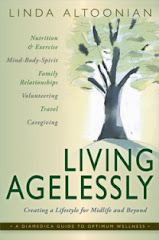I played soccer in junior high, basketball in high school, and I've been dancing since I could walk. I loved every minute, but I'm paying for it now with my knees, and since knee surgery to repair a torn ligament, arthritis has set in big time. Aging and weight gain have also had an impact.
More than 20 million Americans suffer with osteoarthritis (OA), the number one cause of disability in the United States. OA strikes three times as many women as men and most often occurs in people over 50. However younger people who have been injured in sports or accidents can start having symptoms in their 20s and 30s.
OA is a chronic disease, and it will never get better (YUK!). In fact, because the knee pain and immobility are caused by wear and tear between the joints, the symptoms will worsen overtime (YUK! YUK!). Symptoms include pain, stiffness, swelling and inflammation of affected joints and are more prominent after activity (including walking, driving, lifting, standing, bending and climbing), but pain and stiffness can be experienced after resting too, particularly in the morning. OA sufferers also report gaining an average of 42 pounds after diagnosis because they cannot exercise as much, and they often lose two to three hours of sleep at night because of the pain.
In addition to physical symptoms, osteoarthritis takes an emotional toll as well. OA changes lifestyle forever, impacts relationships and the ability to work and be active, and those kind of losses cause depression.
Because of the pain, the tendency is become more inactive, but that will worsen the problem. It is true that if you don't move it, you will lose it. You may not be able to jog any more or even use the treadmill, but you can and should ride a bike and work out in a pool.
Regular exercise will strengthen the muscles around those joints, increase flexibility and blood flow to the affected area, in addition to helping you lose weight. Lightening the load will lessen the pressure on those weight bearing joints, diminish more wear and tear, and decrease inflammation and pain. When, not if, the pain becomes really difficult, medication and injecting steroids can help.
Well, I did all that but still struggled with my knee collapsing, so I took another step as well. My orthopedic physician suggested injections of ultra-pure hyaluronan--which is naturally found in healthy joint fluid. Given as one injection for three consecutive weeks, the protocol helps restore healthy joint fluid to cushion, protect and lubricate the knee joint. It can relieve knee pain for up to six months. In my case, relief lasted an entire year.
The most dramatic course of action is surgery but take care with that decision. I've heard stories of great successes but also terrible nightmares. Seek out a great orthopedic physician for x-rays of your joints and to discuss what options are best for you.
And keep moving. Don't let OA win!
Saturday, June 5, 2010
Subscribe to:
Post Comments (Atom)


So there is another great reason to take Omega 3 besides helping our hearts. Thanks for letting us know!
ReplyDelete